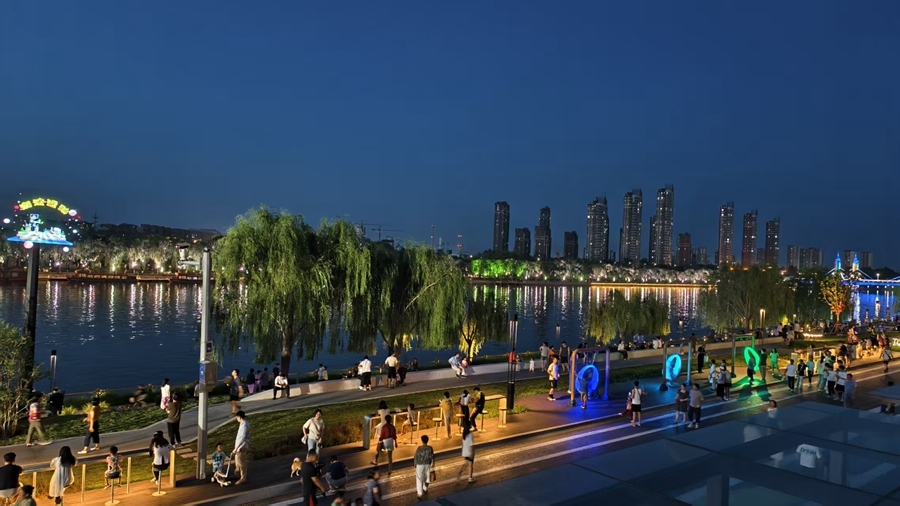International residents toured Beijing's Tongzhou district on Thursday to explore its push for greener development, with stops highlighting history, culture and riverside scenery.
"I have lived in Beijing for seven years, so I'm kind of a Beijinger. I've been to Tongzhou before, but this is the first time I've learned that the Beijing Municipal Administrative Center is located here," said Ekaterina Kaligaeva, a Belarusian vlogger.
"It's very green — greener than other parts of Beijing," she said, adding that the district feels more suburban than Haidian and Chaoyang.
The group visited Luxian Ruins Heritage Park, where ruins dating to the Western Han dynasty (206 B.C. - A.D. 25) have been turned into an urban green space that blends heritage protection with ecological restoration. The roof of the on-site Luxian Ruins Heritage Museum is planted with native vegetation to blend into the surrounding landscape.

The ruins of a Western Han dynasty (206 B.C.-A.D. 25) well at the Luxian Ruins Heritage Museum site in Tongzhou district, Beijing. [Photo provided to China.org.cn]
The park, with 90% of its area covered in vegetation, preserves relics that are more than 2,000 years old while providing nearly 700,000 square meters of green space for the modern city.Archaeologists have uncovered 408 sites dating from the Western Han to the Ming (1368-1644) and Qing (1644-1911) dynasties within the museum's grounds. The museum displays 289 artifacts from the site.
"This is a very good place for families and for people who enjoy nature and fresh air," Ekaterina said. "I see lots of trees, greenery and efforts to protect water and forests. Overall, it just looks green."
Franklin, a Venezuelan student at Beijing Jiaotong University, said Tongzhou's eco-friendly approach could serve as a model for improving urban quality of life. He said Maracaibo, Venezuela's second-largest city, faces intense heat and could benefit from similar green strategies to make life more comfortable.
The group visited the Beijing Bishui Reclaimed Water Plant, which takes an unusual approach to urban infrastructure: Instead of the typical above-ground sewage treatment facility, this plant processes waste entirely underground, allowing the surface to function as public parkland. The facility is the first of its kind in the Beijing Municipal Administrative Center.

A view of the above-ground park at the Beijing Bishui Reclaimed Water Plant in Tongzhou district, Beijing. [Photo provided to China.org.cn]
"The underground facility can treat 180,000 tons of sewage per day, accounting for 56.25% of the district's total reclaimed water capacity, and serves more than 700,000 residents, including supplying water to Universal Beijing Resort," said plant staff member Shi Rui.
Renovations began in 2014, with water operations starting in 2017 and landscape construction in 2021. The site opened to the public in July.
"Before the renovation, the above-ground facilities emitted unpleasant odors, and residents avoided the area," Shi said. "Now, with the equipment underground and odor-control systems in place, the surface is home to 300 plant species and more than 30 bird species, creating a welcoming ecological space for the community."
Phuong, a Vietnamese student at the University of International Business and Economics, said pollution remains a serious problem in Vietnamese cities despite their many rivers and lakes, and no comprehensive solution exists.
"China is doing a great job," Phuong said. "Protecting the environment doesn't mean sacrificing economic development; you can still gain more benefits."
The day ended at the Grand Canal West Bank Pedestrian Street, where visitors took in Tongzhou's evening mix of nature and culture.

People enjoy nightlife along the Grand Canal West Bank Pedestrian Street in Tongzhou district, Beijing. [Photo provided to China.org.cn]
Liu Gang, deputy general manager of Beijing-Hangzhou Grand Canal Culture and Tourism Investment Management Co., Ltd., said the street was once a disused road. It has now been redesigned as a pedestrian waterfront, complete with colorful pavement art, light installations and sculptures.

People watch an open-air film along the Grand Canal in Tongzhou district, Beijing. [Photo provided to China.org.cn]
"Many residents come here to stroll, play instruments, dance, skateboard, jog or play basketball. The street is lined with bookstores, flower shops, toy stores, bars, cafes, and snack stands, and offers boat rides on the canal. It also hosts open-air films and concerts," Liu said. "On weekdays, the area draws 6,000 to 7,000 visitors in the evening. On weekends or during special events, that can rise to 10,000 or even 20,000."
Melo, a Venezuelan student at Beijing International Studies University, said he was impressed by the pedestrian street, where families can unwind after work while enjoying both cultural and natural attractions.


 Share:
Share: 




 京公網安備 11010802027341號
京公網安備 11010802027341號